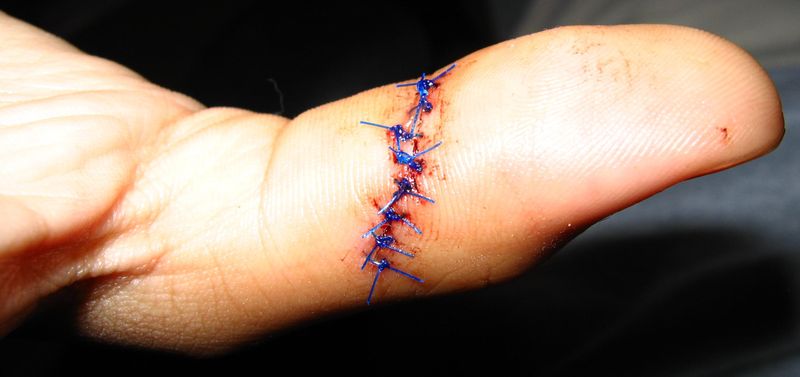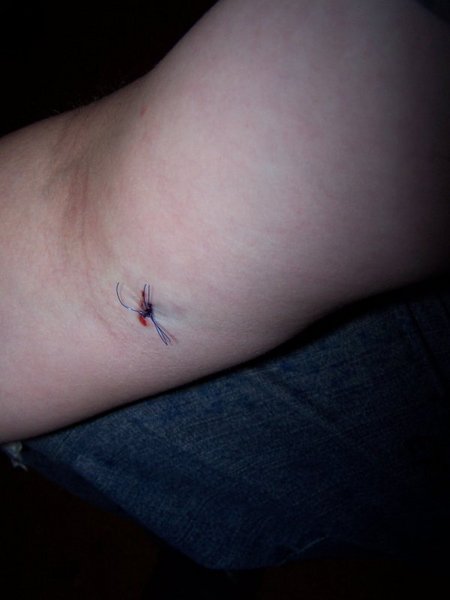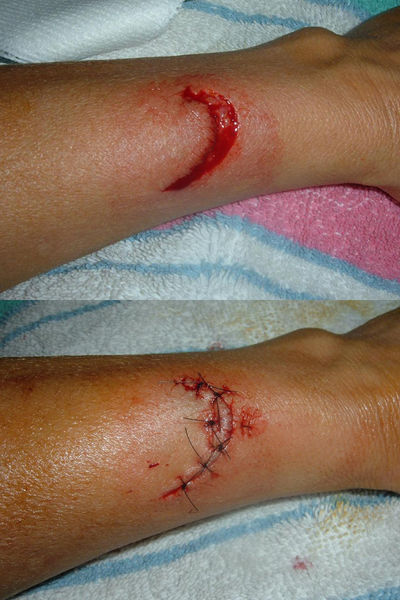Suture
Editor-In-Chief: C. Michael Gibson, M.S., M.D. [1]
A suture is a medical device that doctors, and especially surgeons, use to hold skin, internal organs, blood vessels and all other tissues of the human body together, after they have been severed by injury or surgery. They must be strong (so they do not break), non-toxic and hypoallergenic (to avoid adverse reactions in the body), and flexible (so they can be tied and knotted easily). In addition, they must lack the so called "wick effect", which means that sutures must not allow fluids to penetrate the body through them from outside, which could easily cause infections.
Absorbable and nonabsorbable sutures
Sutures are divided into two kinds - those which are absorbable and will break down harmlessly in the body over time without intervention, and those which are non-absorbable and must be manually removed if they are not left indefinitely. The type of suture used varies on the operation, with the major criteria being the demands of the location and environment.
- Sutures to be placed internally would require re-opening if they were to be removed. Sutures which lie on the exterior of the body can be removed within minutes, and without re-opening the wound. As a result, absorbable sutures are often used internally; non-absorbable externally.
- Sutures to be placed in a stressful environment, for example the heart (constant pressure and movement) or the bladder (adverse chemical presence) may require specialized or stronger materials to perform their role; usually such sutures are either specially treated, or made of special materials, and are often non-absorbable to reduce the risk of degradation.
Absorbable sutures
Absorbable sutures are made of materials which are broken down in tissue after a given period of time, which depending on the material can be from ten days to eight weeks. They are used therefore in many of the internal tissues of the body. In most cases, three weeks is sufficient for the wound to close firmly. The suture is not needed any more, and the fact that it disappears is an advantage, as there is no foreign material left inside the body and no need for the patient to have the sutures removed.
Absorbable sutures were originally made of the intestines of sheep, the so called catgut. The manufacturing process was similar to that of natural musical strings for violins and guitar, and also of natural strings for tennis racquets. The inventor, a 10th century surgeon named al-Zahrawi reportedly discovered the dissolving nature of catgut when his lute's strings were eaten by a monkey. Today, gut sutures are made of specially prepared beef and sheep intestine, and may be untreated (plain gut), tanned with chromium salts to increase their persistence in the body (chromic gut), or heat-treated to give more rapid absorption (fast gut). However, the major part of the absorbable sutures used are now made of synthetic polymer fibers, which may be braided or monofilament; these offer numerous advantages over gut sutures, notably ease of handling, low cost, low tissue reaction, consistent performance and guaranteed non-toxicity. In Europe and Japan, gut sutures have been banned due to concerns over bovine spongiform encephalopathy (mad-cow disease), although the herds from which gut is harvested are certified BSE-free. Each major suture manufacturer has its own proprietary formulations for its brands of synthetic absorbable sutures; various blends of polyglycolic acid (Biovek for example), lactic acid or caprolactone are common.
Occasionally, absorbable sutures can cause inflammation and be rejected by the body rather than absorbed.
Non-absorbable sutures

Nonabsorbable sutures are made of materials which are not metabolized by the body, and are used therefore either on skin wound closure, where the sutures can be removed after a few weeks, or in some inner tissues in which absorbable sutures are not adequate. This is the case, for example, in the heart and in blood vessels, whose rhythmic movement requires a suture which stays longer than three weeks, to give the wound enough time to close. Other organs, like the bladder, contain fluids which make absorbable sutures disappear in only a few days, too early for the wound to heal. Inflammation caused by the foreign protein in some absorbable sutures can amplify scarring, so if other types of suture are less antigenic (ie, do not provoke as much of an immune response) it would represent a way to reduce scarring.
There are several materials used for nonabsorbable sutures. The most common is a natural fiber, silk, which undergoes a special manufacturing process to make it adequate for its use in surgery. Other nonabsorbable sutures are made of artificial fibers, like polypropylene, polyester or nylon; these may or may not have coatings to enhance their performance characteristics. Finally, stainless steel wires are commonly used in orthopedic surgery and for sternal closure in cardiac surgery.

Surgical needles for use with sutures
Traumatic needles are needles with holes or eyes which are supplied to the hospital separate from their suture thread. The suture must be threaded on site, as is done when sewing at home. Atraumatic needles with sutures comprise an eyeless needle attached to a specific length of suture thread. The suture manufacturer swages the suture thread to the eyeless atraumatic needle at the factory. There are several advantages to having the needle pre-mounted on the suture. The doctor or the nurse or odp does not have to spend time threading the suture on the needle. More important, the suture end of a swaged needle is smaller than the needle body. In traumatic needles with eyes, the thread comes out of the needle's hole on both sides. When passing through the tissues, this type of suture rips the tissue to a certain extent, thus the name traumatic. Nearly all modern sutures feature swaged atraumatic needles.
There are several shapes of surgical needles, including:
- straight
- half curved or ski
- 1/4 circle
- 3/8 circle
- 1/2 circle
- 5/8 circle
- compound curve
Needles may also be classified by their point geometry; examples include:
- taper (needle body is round and tapers smoothly to a point)
- cutting (needle body is triangular and has a sharpened cutting edge on the inside)
- reverse cutting (cutting edge on the outside)
- trocar point or tapercut (needle body is round and tapered, but ends in a small triangular cutting point)
- blunt points for sewing friable tissues
- side cutting or spatula points (flat on top and bottom with a cutting edge along the front to one side) for eye surgery
Finally, atraumatic needles may be permanently swaged to the suture or may be designed to come off the suture with a sharp straight tug. These "pop-offs" are commonly used for interrupted sutures, where each suture is only passed once and then tied.
Sizes of sutures
Suture sizes are defined by the United States Pharmacopeia (U.S.P.). Sutures were originally manufactured ranging in size from #1 to #6, with #1 being the smallest. A #4 suture would be roughly the diameter of a tennis racquet string. The manufacturing techniques, derived at the beginning from the production of musical strings, did not allow thinner diameters. As the procedures improved, #0 was added to the suture diameters, and later, thinner and thinner threads were manufactured, which were identified as #00 (#2-0 or #2/0) to #000000 (#6-0 or #6/0).
Modern sutures range from #5 (heavy braided suture for orthopedics) to #11-0 (fine monofilament suture for ophthalmics). Atraumatic needles are manufactured in all shapes for most sizes. The actual diameter of thread for a given U.S.P. size differs depending on the suture material class.

U.S.P.
DesignationCollagen
metric diameter
(mm)Synthetic absorbable
metric diameter
(mm)Non-absorbable
metric diameter
(mm)American wire gauge 11-0 0.01 10-0 0.02 0.02 0.02 9-0 0.03 0.03 0.03 8-0 0.05 0.04 0.04 7-0 0.07 0.05 0.05 6-0 0.1 0.07 0.07 38-40 5-0 0.15 0.1 0.1 35-38 4-0 0.2 0.15 0.15 32-34 3-0 0.3 0.2 0.2 29-32 2-0 0.35 0.3 0.3 28 0 0.4 0.35 0.35 26-27 1 0.5 0.4 0.4 25-26 2 0.6 0.5 0.5 23-24 3 0.7 0.6 0.6 22 4 0.8 0.6 0.6 21-22 5 0.7 0.7 20-21 6 0.8 19-20 7 18
Suture techniques
Common suture stitching techniques include:
- Simple Interrupted Stitch
- Running Stitch
- Mattress
- Horizontal mattress
- Vertical mattress
- Figure 8
- Continuous locking
- Subcuticular
Removal of sutures
Whilst some sutures are intended to be permanent, and others in specialized cases may be kept in place for an extended period of many weeks, as a rule sutures are a short term device to allow healing of a trauma or wound. According to about.com's article on nursing:[1]
- "Different parts of the body heal at different intervals. Common time to remove stitches will vary: facial wounds 3-5 days; scalp wound 7-10 days; limbs 10-14 days; joints 14 days; trunk of the body 7-10 days.
- "Not all stitches must be removed. If a small area remains unhealed, notify the health care practitioner. Then if ordered, remove sutures from the healed area only."
Suture materials
. Plain catgut Chromic catgut Polyglycolic
acid (P.G.A.)Polydioxanone (PDS) Description Absorbable biological suture material. Plain is an absorbable suture made by twisting together strands of purified collagen taken from bovine intestines. The natural plain thread is precision ground in order to achieve a monofilament character and treated with a glycerol containing solution. Plain is absorbed by enzymatic degradation. Absorbable biological suture material. Chromic is an absorbable suture made by twisting together strands of purified collagen taken from bovine intestines. Due to undergoing a ribbon stage chromicisation (treatment with chromic acid salts), the chromic offers roughly twice the stitch-holding time of plain catgut. The natural chromic thread is precision ground in order to achieve a monofilament character and treated with a glycerol containing solution. Chromic is absorbed by enzymatic degradation. It is a synthetic absorbable suture material. Braided synthetic absorbable multifilament made of polyglycolic acid and coated with N-laurin and L-lysine, which render the thread extremely smooth, soft and knot safe. It is a synthetic absorbable suture material. Monofilament synthetic absorbable suture, prepared from the polyester, poly (p-dioxanone). Composition ? Natural purified collagen Polyglycolic acid Polyester and poly (p-dioxanone) Tensile strength Strength retention for at least 7 days. ? ? ? Structure Monofilament Monofilament Braided Monofilament Origin Bovine serosa surface finish. Bovine serosa Synthetic Synthetic through the critical wound Treatment ? Treatment with a glycerol containing solution and chromic acid salts Coated with magnesium stearate Uncoated Type of absorption Proteolytic enzymatic digestion complete by 90 days. Proteolytic enzymatic digestion complete in 70 days. Absorption by enzymatic digestion and starts losing tensile strength on implantation from 18–21 days of catgut chromic Absorption by hydrolysis complete between 60 and 90 days. Always predictable and reliable Wound support can remain up to 6 weeks, however tensile stength decreases to about 70% at 14 days and 25% at 42 days Tissue reaction Moderate. Plain catgut enjoys lower tissue reaction as compared to chromicised. Moderate. ? ? Thread color Straw Brown Violet Violet Size available USP 6-0 (1 metric) to USP 3 (7 metric). USP 6-0 (1 metric) to USP 3 (7 metric). USP 6-0 (1 metric) to USP 2 (5 metric) USP 6-0 (1 metric) to USP 2 (5 metric) Sterilization E.O. Gas. E.O. Gas E.O. gas. E.O. gas Advantages Very high knot-pull tensile strength, good knot security due to special excellent handling features Very high knot-pull tensile strength, good knot security due to special surface finish, improved smoothness due to the dry presentation of the thread, excellent handling features High initial tensile strength, guaranteed holding power through the critical wound healing period. Smooth passage through tissue, easy handling, excellent knotting ability, secure knot tying Tensile strength retention, guaranteed holding power Indications For all surgical procedures especially when tissues that regenerate faster are involved. General closure, ophthalmic, orthopedics, obstetrics/gynecology and gastro-intestinal tract surgery. For all surgical procedures, especially for tissues that regenerate faster. Subcutaneous, intracutaneous closures, abdominal and thoracic surgeries PDS is particularly useful where the combination of an absorbable suture and extended wound support is desirable, pediatric cardiovascular surgery, ophthalmic surgery Contraindications Not recommended for incisions that require the sustaining of the tissues for a prolonged period of time. Not recommended for an incision that requires sustaining of the tissues for a prolonged period of time. This suture being absorbable should not be used where extended approximation of tissue is required. This type of suture being absorbable is not to be used where prolonged approximation of tissues under stress is required and/ or in conjunction with prosthetic devices Precautions Special precautions should be taken in patients with cancer, anemia and malnutrition conditions. They tend to absorb the sutures at a higher rate. Cardiovascular surgery, due to the continued heart contractions. It is absorbed much faster when used in the mouth and in the vagina, due to the presence of microorganisms. Avoid using where long term tissue approximation is needed. Absorption is faster in infected tissues It is absorbed much faster when used in the mouth and in the vagina, due to the presence of microorganism. Cardiovascular surgery, due to the continued heart contractions. Special precautions should be taken in patients with cancer, anemia and malnutrition conditions. They tend to absorb this suture at a higher rate. Special precautions should be taken in elderly patients and patients with history of anemia and malnutrition conditions. As with any suture material, adequate knot security requires the accepted surgical technique of flat and square ties. The PDS suture knots must be properly placed to be secure. Conjunctival and vaginal mucosal sutures remaining in placed for extended periods may be associated with localized irritation. Subcuticular sutures should be placed as deeply as possible in order to minimize the erythema and induration normally associated with absorption.
U.S.P. Needle Pull Specifications
| U.S.P. Suture Size |
Average Minimum (kgf) |
Individual Minimum (kgf) |
|---|---|---|
| 11-0 | 0.007 | 0.005 |
| 10-0 | 0.014 | 0.010 |
| 9-0 | 0.021 | 0.015 |
| 8-0 | 0.050 | 0.025 |
| 7-0 | 0.080 | 0.040 |
| 6-0 | 0.170 | 0.080 |
| 5-0 | 0.230 | 0.110 |
| 4-0 | 0.450 | 0.230 |
| 3-0 | 0.680 | 0.340 |
| 2-0 | 1.100 | 0.450 |
| 0 | 1.500 | 0.450 |
| 1 | 1.800 | 0.600 |
| 2+ | 1.800 | 0.700 |
Other facts
Tissue adhesives
In recent years, topical cyanoacrylate adhesives ("liquid stitches") have been used in combination with, or as an alternative to, sutures in wound closure. The adhesive remains liquid until exposed to water or water-containing substances/tissue, after which it cures (polymerizes) and forms a flexible film that bonds to the underlying surface. The tissue adhesive has been shown to act as a barrier to microbial penetration as long as the adhesive film remains intact. Limitations of tissue adhesives include contraindications to use near the eyes and a mild learning curve on correct usage.
Antimicrobial sutures
Another recent development in wound closure involves the use of sutures coated with antimicrobial substances to reduce the chances of wound infection. While long-term studies are not yet available, preliminary results indicate that these sutures are effective at keeping bacteria out of wounds.
See also
References
External links
| Wikimedia Commons has media related to Category:Suture. |
- Comparison of different types of sutures on Tissue Reactivity and Knot Security
- Demonstration of suturing from medlib.med.utah.edu website
- Latest surgical suture patents information.
- ResidentNet - Types of Sutures.
Template:Operations and other procedures of the integumentary system
de:Nähen (Medizin)
it:Sutura
nl:Hechten
sv:Sutur
Template:Jb1